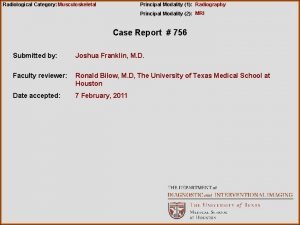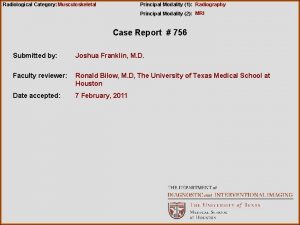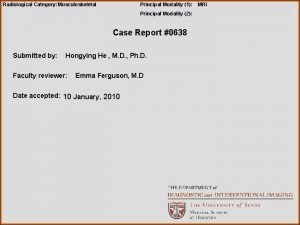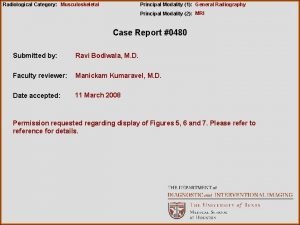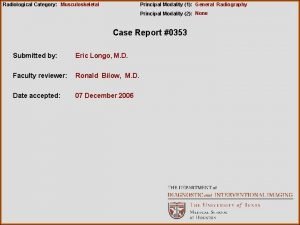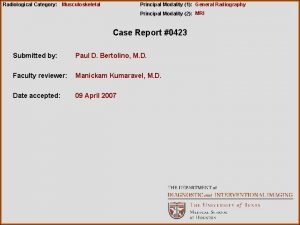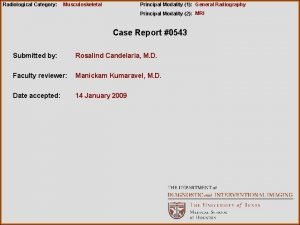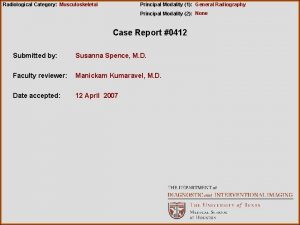Radiological Category Musculoskeletal Principal Modality 1 General Radiography









- Slides: 9

Radiological Category: Musculoskeletal Principal Modality (1): General Radiography Principal Modality (2): None Case Report #0523 Submitted by: James Dimaala, M. D. Faculty reviewer: Manickam Kumaravel, M. D. Date accepted: 14 April 2008

Case History 16 year old male with history of trauma. Patient did not recall loss of conciousness or falling, but now presents with wrist pain.

Radiological Presentations

Radiological Presentations

Test Your Diagnosis Which one of the following is your choice for the appropriate diagnosis? After your selection, go to next page. • Os hamuli propium • Hook of Hamate fracture • Os Hamulare Basale

Findings and Differentials Findings: Normal AP and oblique radiographs of the wrist and hand. Carpal tunnel views demonstrate a linear lucency with irregular margins at the base of the hook of the hamate. Differentials: • Hook of Hamate Fracture • Os Hamuli Propium • Os hamulare basale

Discussion Hook of Hamate fracture – occur in athletes who use equipment with handles e. g. , golf clugs, baseball bats, and rackets. Rarely occurs in patients who fall on an outstretched hand. Carpal tunnel views typically demonstrate fractures at the base of the hook, however, fractures at the extreme base of the hook may not be detected, requiring further evaluation with computed tomography. Os Hamuli Propium – A secondary ossification center in the hook of hamate that does not ossify with the body, located at the palmar aspect of the body where the hook is normally located. Os Hamulare Basale –A secondary ossification center that does not fuse with the body of the hamate located between the distal body of the hamate and the base of the 4 th metacarpal.

Hook of Hamate Fracture Diagnosis A hook of hamate fracture is an infrequent but important cause of wrist pain. Typically, this fracture is seen in athletes of sports involving swinging of a grasped object, with the proximal end of the object in close proximity to the hook of hamate. Slight relaxation at the conclusion of a swing or at the time of meeting sudden resistance results in direct trauma upon the hook [1]. Other cases have been reported following forceful muscular contractions without direct trauma and after direct trauma to the pisiform which produces tension on the pisohamate ligament. Failure to recognize this fracture can result in nonunion of the fracture fragment, which may then lead to late complications such as carpal tunnel syndrome, ulnar nerve palsy, or ulnar artery compromise. Typical radiographic appearance demonstrates a fracture line with irregular margins at the base of the hook. Wrist films and oblique views of the carpal bones may appear normal. Carpal tunnel views are often helpful as in this case. However, fractures at the extreme base of the hook may be missed on carpal tunnel views, necessitating computed tomography for further evaluation. Hook of hamate fractures must be differentiated from normal variants such as os hamuli propium and os hamulare basale, both of which demonstrate smooth and well corticated margins.

References Murray WT, Meuller PR, Rosenthal DI, Rauernek JJ: Fracture of the Hook of Hamate. American Journal of Roentgenology. 1979; 133: 899 -903. Doyle, Botte. Surgical Anatomy of the Hand Upper Extremity. 1 st Edition. Philadelphia, PA: Lippincott Williams and Wilkins; 2003. pgs 55 -56.










